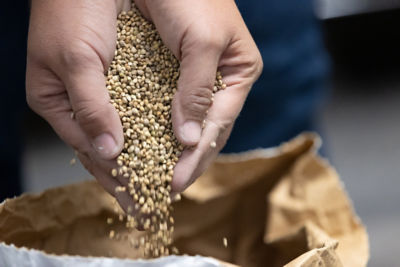Pepino Mosaic Virus (PepMV) is present in many tomato-growing countries, while the relatively new Tomato Brown Rugose Fruit Virus (ToBRFV) is also increasingly common. This creates the possibility that tomatoes can be infected by PepMV, ToBRFV, or a combination of both. Therefore, it is important to understand the best way to protect plants and observe if the order of virus infection creates any differences in symptoms or expression. This article explains the mechanisms behind infection by the different viruses.
What does a virus do in the plant cells: virus multiplication
Viruses consist of genetic material - deoxyribonucleic acid (DNA) or ribonucleic acid (RNA) – a protein coat that protects the DNA or RNA, and a movement protein that helps the organism to move through the plant. The multiplication of the virus’s DNA (or RNA) is actually carried out by the plant cells.
When the virus enters the cell, the plant reads its DNA or RNA and then begins multiplying it, resulting in virus replication. As the RNA is duplicated, the cell begins to make protein coats and movement proteins. Once this has occurred, a new viable virus has been created, which can move to the next plant cell, repeating the process. There will be many copies made of the virus in each cell, resulting in increasing virus titer throughout the plant, and this is infection.

Infections by secondary viruses
When plants are infected by a second virus, this new virus may also multiply quickly within the plant. The replication of the second virus may be exacerbated by the first virus as some proteins essential for infection by the new virus are already in the plant from the first virus. For example, movement proteins of the first virus may be used by the new virus as well to move through the plant.

Viruses can have different effects on each other, and the effects are not always the same. Three different types of interaction can occur between two viruses:
- Synergism: both viruses help each other, and symptoms from both viruses are stronger.
- Antagonism: One virus becomes predominant, and the effects of the other are reduced.
- Neither virus affects the other.
In some cases, ToBRFV is detected with other viruses such as PepMV, Tomato Spotted Wilt Virus (TSWV), Tomato Mosaic Virus (ToMV), etc. It has been observed that leaf symptoms can be more pronounced when ToBRFV infection is followed by PepMV infection.
As such, this is also probably applicable to other viruses such as TSWV or tomato yellow leaf curl virus (TYLCV). It is unknown for all these viruses if such more pronounced symptoms are true synergism or if this is due to other stress factors, such as a sub-optimal growing environment for the plant.
ToBRFV can easily be diagnosed, but even where ToBRFV is found, we will still need to screen for other viruses that are also in the plant, as these may cause some or all of the visible symptoms.

Bayer testing single ToBRFV infection and ToBRFV in combination with PepMV
As mentioned above, there are potentially many combinations of infection, be it ToBRFV – PepMV or vice versa or even tri-infection with TYLCV. Through our observations and technical discussion with our customers, Bayer is evaluating new tomato varieties in two ways that best reflect the real life and common practices of growers: with only a single ToBRFV infection and with a controlled infection of PepMV* followed by ToBRFV infection, here described as co-infection.
*PepMV is introduced via vaccination
In these trials, ToBRFV inoculation is carried out at an early stage, some weeks after planting. Our experience is that young plants are very susceptible to ToBRFV, with the virus multiplying fast and producing visible but not extreme symptoms. There do not appear to be differences in the symptoms caused by a single ToBRFV infection or by ToBRFV infection after vaccination with PepMV. Brown spots and rings are most likely from ToBRFV.
This suggests that young plants are actively growing very quickly, so the virus also increases and reaches high levels very quickly.
No silver bullet to mitigate ToBRFV co-infection
Co-infection with aggressive viruses is a big challenge, as any uncontrolled infections will reduce yields. Growers will need to adopt and maintain a high level of hygiene practices to maximize the number of productive plants and minimize ToBRFV infections at the end of the crop cycle.



